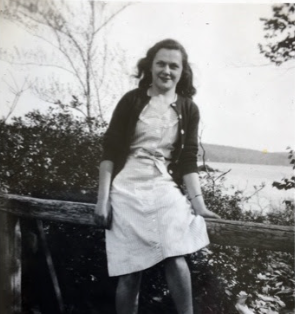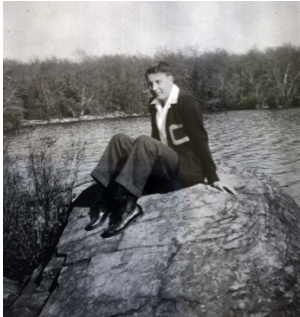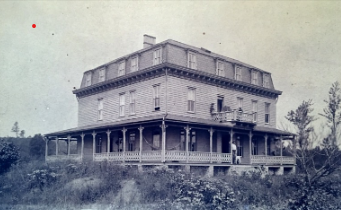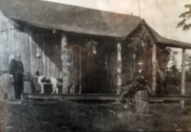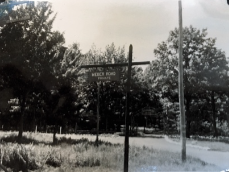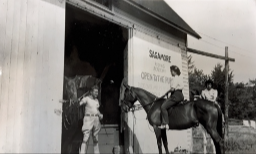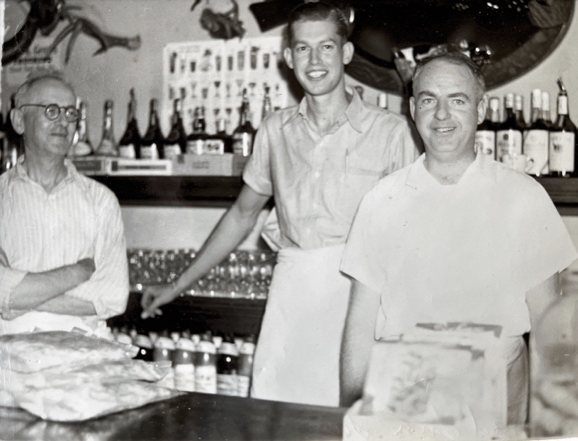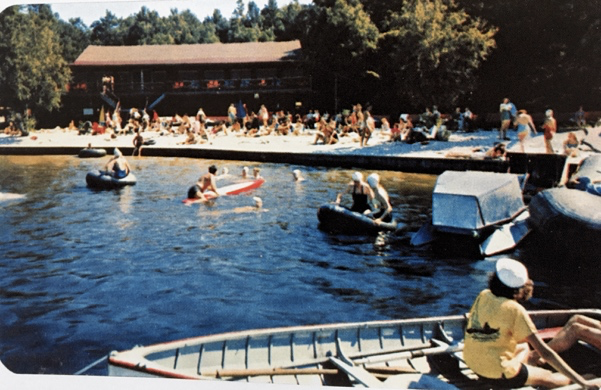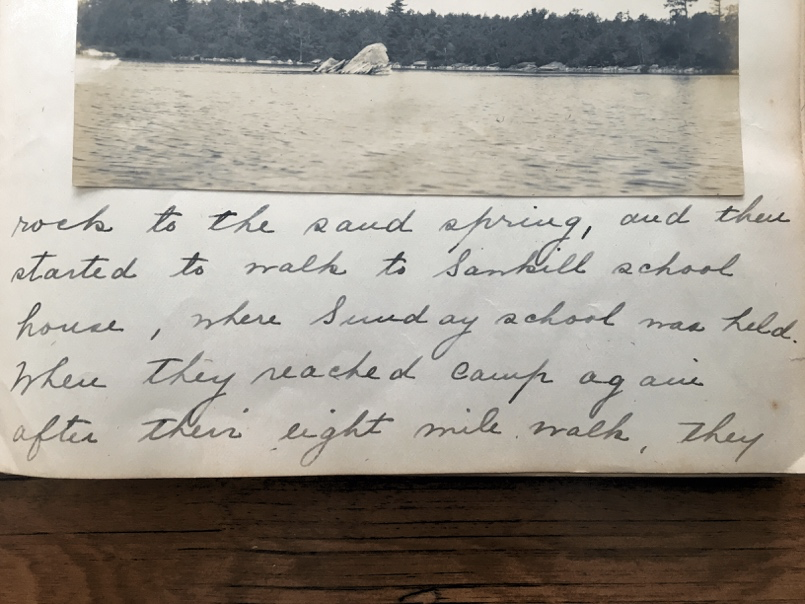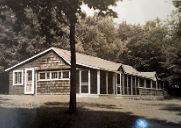
HISTORY articles
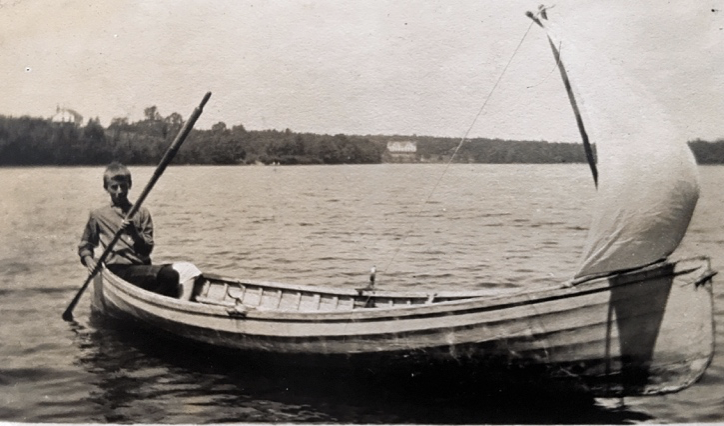
Contents
The Lenni-Lenape | Shohola “Place of Peace”
Back to the Beginning: The Founding of the TLPOA
The Kissing Bridge
Camp Sagamore
The Legitimate School of Singing
A Brief History of the Weber Family at Twin Lakes
A Twin Lakes Memory of the 50’s and 60’s
A Brief History of the Wells Family Camp and “Camp House” on brinks pond
“The Watson House: A Nostalgic Photo Essay” (A blog post by a blogger called, “Anonymous”)
Reflecting back: The showboat
Ficken Fireplaces
a brief history & photographs of the watson hotel
remembering past generations at twin lakes
The Lenni-lenape | Shohola “Place of Peace”
Long before we all arrived to enjoy the pristine waters of Twin Lakes this area was inhabited by the Delaware, Iroquois, Shawnee, Minisink, Lenni Lenape, and Paupack Native Americans.
The Lenni Lenape, ("lun-NAH-pay") were the primary tribe living here and their name translates into “the original peoples.” These American Indians were the first inhabitants of the Pocono Mountains, having settled in the area more than 10,000 years ago. The term Pocono, “Pokawachne” in the native Lenape tongue, means “a river between two mountains.”
The name of our township, Shohola, is the Lenni Lenape word for “Place of Peace”. Indeed, this peace is something we all embrace and appreciate as we grow and bond with our families and friends here. To explore more about the Lenni-Lenape, check out this resource.
Back to the Beginning: The founding of the TLPOA
By Edson Whitney
The first entry in the musty “Minutes” ledger reads: “A self-appointed committee of “lake-front owners” met at the Watson on the evening of August 27th ’27 to discuss the advisability of forming some sort of organization for the mutual benefit of the property owners at Twin Lakes and the general good and welfare of the community. There were present at that time Mr. L.B. Watson, Dr. H.S. Willard, Mr. N.B. Gardiner, Mr. E.B. Morton, Mr. G.W. Stair and Mr. F.V. Stutsman.” They called a meeting of the whole (community) for Sunday evening September 4th.
At Mr. E.B. Mortons, Sunday evening Sept. 4th ‘27
“Dr. H.S. Willard was elected temporary chairman of the meeting. In well-chosen words he presented to those present the aim and objects of the proposed organization. Mr. Morton spoke in favor of the organization and asked for an expression of opinions from those present. There followed speeches, in favor of some such association, by Mr. Gardiner and Mr. Hoff. Mr. Fred Weber asked for further information regarding specific topics for discussion. Dr. Willard again spoke giving the required information…….. Mr. Hoff moved that lake front owners organize…. Mr. Gardiner seconded the motion which was carried.”
The minutes go on record the nomination and election of the officers and charge them to develop the by-laws and decide on the initiation fee which was set a $2.00 per household. The officers elected were Mr. E.B. Morton, President, Mr. Bournique, Vice-President and Mr. F.V. Stutsman, Secretary-Treasurer. There were a total of 20 members who paid the initiation fee.
The executive committee met on September 11, ’27 and the official name of the organization was decided as the “Twin Lakes Property Owners Association”. “After thorough discussion it was decided that because of the trouble and expense necessary to incorporate it would neither be wise nor advantageous to do so.” The By-Laws were proposed and passed by the Executive Committee, after which the meeting was adjourned.
It is interesting to note that of the names of those initial members of the Association, I count at least 5 who still have descendents who own those original properties at Twin Lakes. The association decided in the summer of 1928 to hold a “get together dinner” to celebrate the first year of the association. The invitation is below and the article about the “First Banquet of Twin Lakes P.O.A.” was published in the local paper. 93 people attended at $2.50 per plate at the Watson House and danced until midnight to an orchestra from Port Jervis. I guess those early pioneers at Twin Lakes had staying power and liked to party!
The Kissing bridge
80 years ago this summer a young girl from Matamoras was staying at a cottage on the Big Lake named “Wimbledon”, built by Bob and Lottie Chant in 1936 and named for their hometown in England. The girl and her cousin knew that the counselors from Camp Shawnee on the Little Lake canoed through the channel between the lakes and brought the campers into the Big Lake on Sunday evenings. They decided to go to the bridge between the lakes and wait for this excursion. As fate would have it, that evening two of the counselors canoed through without the campers. Seeing the girls on the bridge they chatted a while and asked them if they would like a canoe ride back to their friend’s cottage. The girls said yes and the polite young men paddled them home and met the parents staying there.
The one young man, from Port Jervis, went off to college and was drafted during World War II and eventually stationed in England. He and his passenger lost touch, until the girl from Matamoras was helping the war effort by packing care packages for local soldiers abroad. She saw one package was for the counselor she had met on the bridge and included a personal note wishing him well. They picked up a correspondence through “V mail” and began dating after he returned from the war. Edson Whitney married Nancy Fowler in 1946 and in 1953 they purchased Wimbledon, where she had been staying the evening they met. They spent every summer at the cottage and, when they retired, started the tradition of stopping the car and sharing a kiss on the bridge every time they crossed it. The grandchildren and their friends witnessing this from the back seat, named it the “kissing bridge, and another Twin Lakes legend began. “Wimbledon” is now the summer home of Sander and Jacie Jacobowitz and their twin boys.
By Edson Whitney
Camp Sagamore
by Edson Whitney
A thriving bustling resort in the 30’s, 40’s, 50’s and into the 60’s before closing in the mid 60’s, Camp Sagamore boasted horseback riding, tennis, sailing, volleyball, softball, swimming, skeet shooting, archery, badminton and live music for dancing in the “Showboat” as well as an airstrip behind the current Shohola Elementary School. Opened by Burt, Eddie and “Brick” Lloyd in the 1930’s as a “Christian Adult Summer Resort Camp” Sagamore attracted young singles and married couples from all over the Northeast.
Campers stayed in rustic bungalows in three different areas of the camp, one for married couples, an area for men and one for women. The men’s and women’s lodging were dormitory style with 10 persons per bunkhouse. The campers used designated shared bathroom facilities. Back in the day weekly rates started at $21! At its height there were more than 60 buildings at the camp. Each camper was assigned a “camp name” for their stay and the staff had nicknames too, including the lifeguards “Torpedo” and “Diver” and the night watchman “Goosestep”.
The “Showboat” on the lake was the center of the evening activities which included a live seven piece orchestra which performed from Monday through Saturday for dances and talent shows. The Husson brothers or Phil Judd performed on Wednesday nights and called for square dancing. Eddie Lloyd sang on amateur night on Fridays and had a beautiful singing voice. While we all enjoy our peace and quiet today, the sound of the Sagamore band on the loudspeakers over the lake on Saturday evenings was part of summer life on the lake.
On Sunday mornings Catholic and Protestant church services were held in the Showboat and many Sunday mornings we went there instead of the longer drive to Shohola.
The 85 foot tall observation or “fire” tower, which offered views of the lake, was originally near the George Washington Bridges and was reassembled at Sagamore in the 1930’s. The large dining room, called the “Bamboo Room, near where the tennis courts are, served all the meals and could seat 400. Barbara remembers as a kid going to husk corn for the campers at the dining room. The motivation was the reward of a quarter and sometimes a dollar bill hidden in the some of the husks for the lucky one who got that ear!
Since Sagamore did not serve alcohol on the premises in the early years, Hinkel’s Bar (now the Fork) was a popular place in the evening and the bar had ceramic beer mugs with the camp names of all the regulars for their drinks in the evening.
Some of the newer residents may not be aware of this but Twin Lakes had a motorboat back in the day for emergency and rescue purposes. It was owned by Sagamore and was used mostly to retrieve the “Beetle” sailboats that were becalmed when the wind died in the evening. The familiar call over the loudspeaker in the evening was “Will all Sagamore rowboats, canoes and sailboats please return to the t-dock”. The story goes that the “sandy beach” sand was imported from the New Jersey shore and shipped in boxcars on the Erie Railroad to the station in Shohola where it was trucked up to Twin Lakes.
As teenagers, I and my group were fortunate to be friends with Raymond Lloyd, the son of owners Eddie and May, and so had free access to the Showboat, the ice cream and soda fountain on its ground floor and to the volley ball games on the beach. The lake was a much livelier place back then with Sagamore, the Watson House, the Cos- Mid Inn for pizza, pool and a great juke box, bingo night at Hinkel’s, Simons cottages and ice cream stand near the dam, and the Twin Lakes Post Office where we could pick up the mail and get a Creamsicle. More on these places in a future article.
Credit for most of the information in this article to Skip Gregory and his treasure of a book “All Roads Lead to Milford, Pennsylvania”.
The Legitimate School of Singing
by Edson Whitney
This was the title of the book by Francis Charles Maria de Rialp who built the elegant “Villa de Rialp” pictured below on the Twin Lakes Road property now owned by Carol Husson whose husband Gene was a descendent by marriage of “Frank” de Rialp.
The Villa de Rialp, constructed in 1885 at a cost of $2,786.52, housed students from Rialp’s New York music school during the summer when they relaxed at the then “Brink Pond” and studied voice at “El Pardo” as he named the school. From a newspaper article of the day, “His pupils enjoyed driving, bathing and rowing on the beautiful lake belonging to the estate.”
Frank de Rialp was born in Barcelona and, after serving in the Spanish army during the war with Morocco, studied music and pianoforte under Schoenbrun, a pupil of Berlioz. Following his studies he spent 16 years in London as “Maestrino” before moving to New York City where he opened his music school at 15 East 16th St. He married the sister of Lillian Husson’s mother. Lillian’s mother died young and she was raised by her “Auntie”, also named Lillian, de Rialp. Aunt Lillian sold most of the property, including Villa de Rialp, to the Lloyd family and this is where Camp Sagamore was built. The current Husson property on Twin Lakes Road and “Raccoon Camp” on the lake were retained in the Husson family.
The vocal tradition was passed down to Lillian’s son, Gene Husson, who played fiddle and sang at the Sagamore Showboat (and jammed with the bluegrass band at Barbara’s and my wedding) and his daughter, Gail Husson who just released her first CD, “You Would Have Been Proud” dedicated to her parents. Gail plays guitar and sings her original songs, including one called “Snowy Road” about walking down Jacob Weber Road on a winter’s eve. This magnificent house was used as housing for the Camp Sagamore caretakers until it was razed in the 60’s and remains but another fascinating story of the Twin Lakes community. Frank de Rialp is buried, with other family members, in the family graveyard on the Husson property, near his beloved summer home and music school. Many thanks to Carol, Gail and Linda Husson for providing the material and photos for this article.
A Brief History of the Weber Family at Twin Lakes
Barbara Brown’s Great Granddaughter, Eva, is the seventh generation of the Weber family to enjoy Twin Lakes. Barbara’s Great Grandfather, Jacob Weber, bought the four hundred and forty acres on the south shore of Twin Lakes in 1901. This was the tract from the original land warrant of Mary Rustin, deeded to her in 1793 by the new government of the United States of America as payment for her families’ service in the Revolutionary War. Jacob Weber was a Methodist minister who had congregations in Dingman’s Ferry, Shohola and Barryville. He and his wife, Henrietta Adams, had five sons: Charles, Harry, George, Fred and Frank Pinchot Weber, who was the grandfather of Barbara. He was born in Dingmans Ferry and attended Shohola school.
By Edson Whitney
The family built a hunting and fishing camp on the lake between what is now Barbara’s current home and the cottage on the property. In a letter written from “Camp Weber” on June 19, 1905 by Jacob to his son Fred and his wife Alice who were coming for a visit, he poetically writes: “When the shade of night has fallen the Frogs play on their stringed instruments all the popular airs of Frogdom, such as Jug a rum & Chim pan zee so you know what you are coming to & what to expect besides cold water and Sun burn”. The “PS” to the letter states “Bring me a writing pad or you won’t get any more letters”
Over time the family built other “camps” on the property including the current cottage of Robert McKee, Jr., next to the Whitney’s home. The interesting story about this structure is that it was originally a Military Hospitality House in Virginia. George Weber had it dismantled and shipped from Virginia in the winter and slid across the ice from a point between the lakes and reconstructed on the current site.
Fred Weber and his wife Alice built a camp on the property up on the hill on the site of what is now the home of Bill and Marianne Hutchinson. The original camp was torn down and replaced with the current structure built by Robert and Blanche McKee in 1974.
Back in the day the Weber’s Uncle Tom, visiting from New York City, would come up the mountain from the train station at Parkers Glen by buckboard wagon driven by Ira Hoffman. From a point between the lakes he would sound his bugle to let the Webers know he had arrived. The Weber girls would then row across and pick him up by rowboat to reach their camp on south shore. Jacob Weber Road (formerly Weber Road) was constructed in 1904 after the Webers purchased a deeded right of way for $25 from Frank D. Rialp, who owned what is now the Sagamore Estates property.
Frank and his wife, Agnes Coffey, were the only Webers to have children, Florence and Helen. Helen married Elmer Ericson and are the parents of Barbara Brown who married Richard Brown in 1950. Barbara has four children, five Grandchildren and a Great Granddaughter, all of whom continue to enjoy Twin Lakes.
As a young girl Barbara spent every summer at Twin Lakes enjoying all the activities we do now, but with the addition of horseback riding at the stables at Camp Sagamore. The barn on the left of Twin Lakes Road just before Jacob Weber Road, now owned by Linda Husson (descendent of the Rialp family), was the stable for the horses. Barbara remembers chores like bringing up pails of water from the lake for cooking and washing and fetching water for drinking from the spring on the property. Going to the icehouse behind George’s cabin was a treat as her father would give her a ride in the wheelbarrow to get there. Linda and Gail Husson’s grandfather, Leon Husson, would cut and store ice cut from the lake in the winter.
In 1999 Barbara and her husband, Dick Brown, generously deeded 153 acres of the original property to the Delaware Highlands Conservancy which is now under the protection of the Twin Lakes Conservancy and is known as the Frank Pinchot Weber Tract. It will remain forever green and pristine. Barbara Whitney and I are fortunate that, when we approached Barbara and Dick in 1993 asking about the possibility of them selling what is now our parcel of property at the end of Jacob Weber Road and part of the original acreage of Jacob Weber’s tract, they agreed and we purchased our 3.5 acres from them in 1997.
Barbara Brown continues to spend all her summers at Twin Lakes and her children, grandchildren and great granddaughter all enjoy time together on the lake thanks to the legacy and visionary purchase by Jacob Weber and his five sons those many years ago.
With many thanks to Barbara Brown and her family for their stewardship of Twin Lakes and sharing their photos and history with me. This is based on excerpts from Barbara Brown’s history of her family at Twin Lakes and interviews with Barbara in the Autumn of 2020.
A Twin Lakes Memory of the 50’s and 60’s
By Edson Whitney
Movie night at the Watson House, bingo night at Harley Hinkel’s bar and gas station, creamsicles from the freezer when picking up our mail at the Twin Lakes Post Office with Martha Hinkel, the Post Mistress, in her green visor, pizza and dancing to tunes on the juke box at the Cos-Mid Inn, popsicles from Simons cottages and public beach by the dam and Camp Sagamore’s motor boat towing in the stranded sailors in the Beetle Boats in time for dinner in the Bamboo room. These are a few of my memories from the 50’s and 60’s at Twin Lakes, a much livelier and busier place in those days. Livelier and busier though since the late 50’s I counted and there are now 55 more new lakefront homes on the two lakes than there were back before 1960.
My family rented “Wimbledon” (202 Coursen Road, now the summer home of Sander and Jacie Jacobowitz) from their family friends Bob and Lottie Chant in the summer of 1953 and bought the cottage in 1954 when we spent our first full summer there. The NY Herald Tribune was delivered on Sundays from the back seat of the sedan of the delivery guy. Fresh bread and pastries arrived weekly (or twice a week?) with the honk of a horn from the bread truck at the top of the driveway when the owner and his long-legged daughter would let us barefoot into the truck stepping on the warm metal floor, inhaling the delicious smells of all the goodies the shelves held.
Two boys about my age spent the summers next door in “Tatra” (summer home of Todd and Katherine Plitt) and we were free to roam everywhere all day as long as we came home for dinner when we heard our respective bells ring out. What is now the Coursen Conservancy was our backyard and we explored all the old logging trails building forts and tree houses. At age 7 or so we would walk the then gravel road from our cottages for swimming lessons from Joan Chariere (sister of Jerry Mihaly) and change upstairs over the garage. The treat after swim lessons was talking to Isaiah, the chauffer of the Dougherty’s next door (now Barbara Dahan’s house) as he polished the big black Chrysler Imperial with those magnificent tailfins. A car like that was a magnet for any boy of the era.
We could walk to Simon’s concession stand and with a dime buy some ice cream and then pump some fresh well water in the pumphouse (Fern Rock now owned by Robbie Bielman) and use the metal cups hanging on the natural log beams. If Mr. Simon was there we would have long conversations with him in the shade of the pumphouse. The beach area and rowboats were for the public who paid a day fee for the use of the boats and the lake. (the beachfront by the dam where Dave and Bonnie Miller have their boathouse).
St. Ann’s church in Shohola ran bingo games at Harley Hinkel’s (now The Fork) on Wednesday nights in the summer and my grandmother didn’t miss one if she was staying with us that week. There were gas pumps out front and my father always joked that Harley would go out and pump some gas and then come back to the bar and pour a beer while his hands still smelled of gas fumes. Martha Hinkel ran the Post Office and the small general store where we could buy bread and popsicles. (Now the parking lot to the left of The Fork). Letters were addressed to “Name”, Twin Lakes, Pennsylvania. This was before the houses had numbers and before ZIP codes!
The Watson House was the old boarding house on the Little Lake that showed movies on Thursday nights and had a candy counter as well. Outside guests could also enjoy a family style dinner there in the dining room. (Now Brantwood named after Brant Watson).
Further down the road was the Cos-Mid Inn (the last version of this establishment was the Windy Dog) run by Charles (Cos) Costello and his wife Dorothy, parents of our own President, Beth Nikles. A real roadside bar with burgers, pizza, a pool table and a juke box it was a great local hangout for kids and adults alike. The long clothesline above the bar had various items of clothing (dare I say including some undergarments?) and bells. To welcome back returning guests Cos would take a cane and pull on the line to ring bells and then end with a big clang of the railroad engine bell mounted at the end of the bar. I will let Beth tell more of the story in a future article, but she has shared with me that her dad threw none other than Frank Sinatra out of the bar and once allowed Jane Mansfield to use the bathroom one Sunday morning on her way to the Catskills. Paul Newman also stopped by occasionally on his way from Connecticut to his race car events in Watkins Glen.
L to R: George Schmidt, George Voigt, MD, and Charles (Cos) Costello at the bar the first year they opened in 1946. It was named Cos-Mid Inn from the 3 letters of the 2 last names.
And Camp Sagamore, when we were teenagers we had the run of the place thanks to our friend, Raymond Lloyd, son of Eddie and Mae Lloyd, the owners. Can you imagine anyone now playing music over the loudspeaker for the whole lake to hear on a Saturday night, or a motorboat rescuing stranded campers in their sailboats when the wind died in the late afternoon? And we always knew what time it was when the loudspeaker would bellow out across the lake, “All Sagamore rowboats, canoes and sailboats please return to the T-dock”, to get the campers back in time for dinner in the Bamboo Room dining hall up by the tennis courts. That was all part of the lake life with a live band and dancing every night in the Showboat on the beach and Catholic mass and a Protestant service in the same venue on Sunday mornings with a distinct smell of stale beer in the air. We were also invited to play in the volleyball games on the beach there during our teen years.
Of course, sailing was an everyday pastime and the weekend races had sunfish, sailfish and sharks. The dock parties were actually on the docks where each race started and ended as they rotated among the hosts, including the Little Lake at least once every season. We all tied our boats up to the dock of the host and went as we were, no sailing home to put away our boats and change first.
The rocks and hills all had names back then. The first hill coming down Between the Lakes Road to the bridge from the archway was Singsen’s Hill named for the owners of the house on the right at the top; the hill up from the fork where Kenworthey splits off was Simon’s hill named for Grover Simon who owned Fern Rock and the cottages on the hill (Miller and the 3 sisters); the big rock in East Cove was Squawfoot Rock (a non-PC name now); and the point where Ron and Dina Feldman’s house now stands was Watson’s Point. It was owned by the Watson House and they used to bring their guests over by boat from the Little Lake for bonfires and picnics at the empty lot on the point.
The lake was a lot busier then, sometimes loud and boisterous, but with so much more to do for both the kids and the adults. Most of us kids were lucky to spend the whole summer here as, in those days, for the most part, the Dad worked and Mom was home with the kids. The Dads either commuted every day if they worked in Milford or Port Jervis or went to the winter home for the week and came back up on weekends. Spending the whole summer we were able to form lake friendships for life as with Lynn Nordstrom’s older sister Debbie and Barbara’s cousin Fran Puntillo and, for me, marriage to the former Barbara Thomsen who spent summers at her family’s cabin on Jacob Weber Road and is the younger sister of my friend Fred. Even as teenagers, we never complained about missing our friends back home because the lake was our home for the entire summer. We were in the wonderful comfortable bubble of our mountaintop retreat, without cell phones or any electronics to pacify us, just enjoying those lazy days of summer.
A Brief History of the Wells Family Camp and “Camp House”on Brinks Pond
By Edson Whitney
The first page in the camp log book with the heading “1886” reads: Founding of Camp by Wells family at Brinks Ponds “Big and little” Pitched tents August first. Souvenirs: Camp picture cabinet size of young folks.
The next entry is August 2. 1887 came into camp. Stayed 10 days. Souvenir of 1887: Wooden plates with autographs.
August 2: 1888 Came into camp. Renamed the place “Twin Lakes”. Souvenirs for 1888 were Home made toasting forks, birch bark napkin rings and birch bark booklets with autographs.
1889 opened camp August 15th Guests, 8 of the Wells family from Port Jervis and 13 others. Souvenir: book of original poetry by the girls and illustrated by Fred Wells, amateur photographer.
Then it jumps to August 8 1892. Souvenir of 1892 Booklet Camp poem by Uncle Peter Wells birch bark cover. “This is the first year in the camp house. Before this camped in tents always had four or five tents.”
The Wells Camp House, pictured here, was built in the year 1892, the foundation of which still remains on the north side of the home of Alice Jane and Peter Loewrigkeit. The journals tell of the campfires the many fish they caught daily and their walks to Parker’s Glen and to the Sawkill schoolhouse for Sunday school an 8 miles round trip stroll!
In 1894 Stephan Crane, author of the Red Badge of Courage spent the month of August at Twin Lakes at the Camp. He and his friends published the “Pike County Puzzle” a spoof on the local newspapers filled with silly and fanciful stories, loosely based on events of the summer.
An 1896 entry reads, “July 27. 8.a.m. Our party of seven left PJ (Port Jervis) in a big livery stage driven by George Farnum. Besides bundles, baskets, boxes and suit-cases there were (lists the names of all 7 passengers). Drove through Milford and took in Aunt May and Sarah Newman. Reached camp at 1:30…..”
(another entry) “Saturday afternoon walked to Parkers Glen and went through the stone quarry. Killed a deer weighing 175 lbs., killed 3 ducks, caught 20 pickerel. How is that for one day.”
The next entry begins “Sunday came, very hot and bright, and in the afternoon they crossed the big lake, past Squaw foot (see writing under the photo) rock to the sand spring and then started to walk to Sawkill school house, where Sunday school was held. When they reached camp again after their eight mile walk, they….”
So “Squaw Foot Rock” remains a feature of the Big Lake and the “sand spring” is still feeding the lake between the original Camp Sagamore Beach and the current Twin Lakes Park community beach. I can’t find the location of the Sawkill schoolhouse however, with an 8 mile round trip walk, perhaps 4 miles down the Sawkill Road from Sagamore?
On Sunday evenings they would hold singalongs of hymns on the lake.
“The boats and canoes from the different camps and cottages and from the Watson, came out, until there were fifteen or more, all held together in the middle of the lake, and all filled with friends singing hymns. It was a beautiful evening service, one long to be remembered by everyone who was there.”
There is much more to tell about the history of the Wells family and Twin Lakes but I will save that for another issue. Meanwhile you might enjoy seeing what may have been the first sailboat on the lake. The journal says that young Donald Malvin, son of Isadora Wells and Frank, took a large dish towel and fashioned the sail and enjoyed sailing for three days on the lake…. The photo is on the Little Lake and the Watson House is the building in on the far shore.
With great thanks to Karen Layland Allen for the time spent sharing the journals and photos of her husband’s family records. The rustic, natural log cottage “Interlaken” where Karen, as well as John and Nancy (Allen) Rupke, spend summers was the next camp to be built in 1904 by Frank Malven who was married to Isadora Wells. It is the same structure still existing today and its history will be the subject of a future story to be told here.
By Gail Husson
By David Branham
By Suzanne Yerdon
By Edson Whitney

